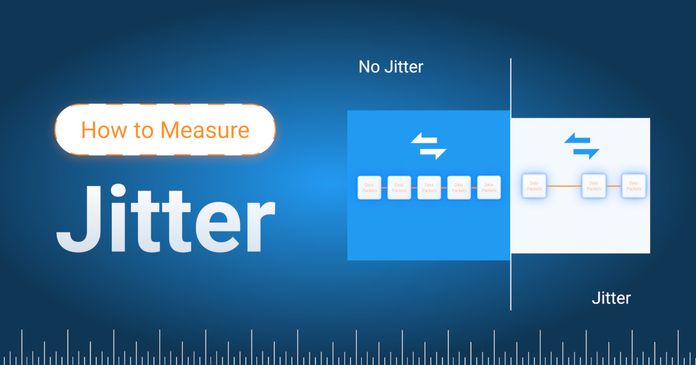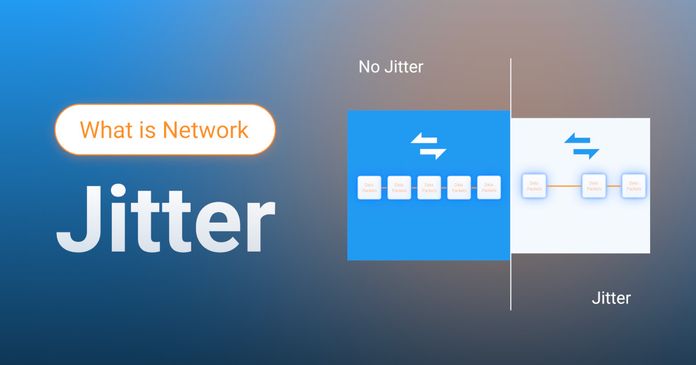Table of Contents
Table of Contents
Are you tired of sounding like a robot on your VoIP calls? Or maybe you're just sick of hearing your colleagues sound like they're calling from the bottom of a well? Fear not, my friends, for the solution to your VoIP woes is here! Introducing VoIP Monitoring 101: Keeping Your Calls Crystal Clear.
In this article, we'll break down everything you need to know about VoIP monitoring - from what it is to why it matters - so you can say goodbye to poor call quality and hello to crystal-clear conversations. So, grab your headset and get ready to learn how to make your VoIP calls sound like they're coming from the other side of the world (in a good way, of course).
VoIP stands for "Voice over Internet Protocol," which is a technology that allows you to make voice calls over the Internet instead of using traditional telephone lines. With VoIP, your voice is converted into digital data packets that are transmitted over the internet, just like any other type of data.
This means that you can make phone calls from anywhere with an internet connection, and you can use a variety of devices to do so, including computers, smartphones, and VoIP-enabled desk phones. VoIP offers many advantages over traditional telephone systems, including cost savings, scalability, and advanced features like video conferencing and unified communications.
VoIP monitoring is like having your own personal call-quality superhero - always watching out for you, ready to swoop in and save the day at a moment's notice. In this section, we'll break down everything you need to know about VoIP monitoring, from what it is to why it matters, so you can keep your calls clear and your stress levels low.
VoIP monitoring is the process of observing and analyzing the performance of a VoIP (Voice over Internet Protocol) system in real-time to ensure that it is functioning optimally. This can involve monitoring various aspects of the system, such as VoIP quality, network bandwidth, latency, jitter, and packet loss, among others.
VoIP monitoring tools can help detect and diagnose issues that may affect call quality, such as poor network conditions, faulty hardware, or software configuration problems. By monitoring VoIP system performance, businesses can proactively identify and resolve issues before they impact the quality of calls and negatively affect customer satisfaction. VoIP monitoring is an essential practice for businesses that rely on VoIP for their communications, as it helps ensure that their system is running smoothly and their calls are crystal clear.

Attention, all IT specialists and network admins! Brace yourselves, for we have a crucial message to deliver. VoIP monitoring is not just a luxury; it's an absolute necessity for businesses seeking to maintain impeccable communication standards. If you're the guardian of network performance, the troubleshooter extraordinaire, then this article is your golden ticket.
Prepare to unravel the secrets of VoIP monitoring, armed with tools and knowledge that will empower you to conquer call quality challenges, optimize network infrastructure, and ensure seamless communication experiences. Step into the spotlight, IT specialists and network admins, as we embark on a journey tailored especially for you. Your expertise is about to shine brighter than ever before!
By keeping a watchful eye on your VoIP system, you can make sure it's running like a well-oiled machine and delivering the best possible experience to your customers.
VoIP monitoring is important for businesses for several reasons:
- Ensuring call quality: Poor call quality can negatively impact a business's reputation and lead to customer dissatisfaction. VoIP monitoring tools allow businesses to proactively identify and address call quality issues before they become a problem.
- Minimizing downtime: VoIP monitoring tools can help businesses detect and resolve issues that may cause system downtimes, such as network congestion, equipment failures, or bandwidth limitations.
- Improving productivity: Clear and reliable communication is essential for businesses to operate smoothly. VoIP monitoring tools can help businesses optimize their VoIP systems to ensure that employees can communicate effectively and efficiently.
- Reducing costs: VoIP monitoring tools can help businesses identify areas where they can reduce costs, such as by optimizing their bandwidth usage or identifying and replacing faulty equipment.
- Meeting regulatory requirements: Some industries, such as healthcare or finance, have strict regulatory requirements for the security and privacy of communications. VoIP monitoring tools can help businesses ensure that they are meeting these requirements.
Overall, VoIP monitoring is essential for businesses that rely on VoIP for their communications. By monitoring call quality and other metrics, businesses can proactively identify and address issues, improve their operations, and provide the best possible service to their customers.
Ready to unleash your inner VoIP superhero? Say goodbye to choppy calls and hello to crystal-clear conversations with Obkio! With our easy-to-use VoIP monitoring tools, you can keep your system running smoothly and make sure your calls are always top-notch.

- 14-day free trial of all premium features
- Deploy in just 10 minutes
- Monitor performance in all vital network locations
- Measure real-time network metrics
- Identify and troubleshoot live network problems
So, what are you waiting for? Don't let poor call quality hold you back -
And join the ranks of VoIP superheroes!

In the world of VoIP, quality is king, and that's where VoIP monitoring comes in. By keeping a watchful eye (or ear) on your VoIP system, you can ensure that your calls are always crystal clear, reliable, and free of static, echoes, and other pesky issues.
VoIP quality refers to the clarity, reliability, and overall performance of voice calls made over a VoIP system. Factors that can impact VoIP quality include network congestion, bandwidth limitations, latency, packet loss, and jitter. When these issues arise, they can result in poor call quality, such as dropped calls, echoes, distortion, and delay.
VoIP monitoring is crucial for maintaining high-quality VoIP communications. By continuously monitoring various aspects of a VoIP system, businesses can identify and diagnose issues that may affect call quality in real-time.
VoIP monitoring tools can provide insights into network performance, call quality metrics, and usage patterns that can help detect and troubleshoot issues that impact VoIP quality. This proactive approach can help prevent poor call quality before it becomes a significant problem, ensuring that calls are crystal clear, reliable, and meet customer expectations.
In summary, VoIP quality and VoIP monitoring are closely related, as VoIP monitoring helps maintain optimal VoIP quality by identifying and resolving issues that can negatively impact call quality.
VoIP Quality is typically measured using a combination of objective and subjective metrics. Here are some common methods for measuring VoIP Quality:
- MOS score: The Mean Opinion Score (MOS) is a subjective metric that is obtained by having a group of people rate the quality of audio samples. MOS scores are widely used in the telecommunications industry to assess the quality of VoIP calls. We'll expand on MOS Score in the next section.
- R-factor: The R-factor is an objective metric that is used to measure the quality of VoIP calls. It takes into account factors such as delay, jitter, and packet loss to produce a score between 0 and 100. A higher R-factor indicates better call quality.
- Packet loss rate: Packet loss rate is the percentage of voice packets that are lost during transmission. A higher packet loss rate can result in poor call quality.
- Jitter: Jitter is the variation in delay between packets. High jitter can result in poor call quality.
- Latency: Latency is the delay that occurs between the time when a voice packet is sent and when it is received. High latency can result in poor call quality.
- Echo: Echo occurs when a caller hears their own voice back in their earpiece. Echo can be caused by network delays, poor echo cancellation, or other factors, and can result in poor call quality.
By measuring these metrics, VoIP service providers can identify areas where call quality needs improvement and take steps to improve the overall quality of their services.
Ever wonder what's going on behind the scenes of your VoIP calls? Well, wonder no more! With VoIP monitoring, you can be your own personal call quality detective, tracking down pesky issues like echoes, jitter, and packet loss.
To monitor VoIP quality with VoIP monitoring tools, you need to track several key metrics that can impact call quality, including network performance, latency, jitter, packet loss, and call quality metrics.
Here are some common ways that VoIP monitoring tools can help you track these metrics:
- Network performance monitoring: VoIP monitoring tools can help you monitor network performance and detect issues that may impact call quality, such as high traffic, network congestion, or network equipment failures.
- Latency and Jitter monitoring: VoIP monitoring tools can track latency (the time it takes for a packet to travel from the sender to the receiver) and jitter (the variation in latency between packets). High latency and jitter can cause delays and poor call quality.
- Packet loss monitoring: VoIP monitoring tools can also track packet loss, which occurs when packets are lost or discarded during transmission. High packet loss can cause audio issues and dropped calls.
- Call quality metrics monitoring: VoIP monitoring tools can track call quality metrics such as MOS (Mean Opinion Score), which is a standardized measure of call quality. By monitoring these metrics, you can quickly detect any issues that may impact call quality and take action to resolve them.
Overall, VoIP monitoring tools provide businesses with a comprehensive view of their VoIP system's performance, allowing them to quickly identify and troubleshoot any issues that may impact call quality. By monitoring these metrics regularly, businesses can ensure that their VoIP system is running smoothly and that their calls are crystal clear.


VoIP quality is typically measured using a standardized rating system called MOS (Mean Opinion Score), which rates the quality of a voice call on a scale of 1 to 5. MOS scores are calculated based on subjective ratings from human listeners who rate the call quality based on factors such as clarity, background noise, and echo.
The Mean Opinion Score, usually referred to as MOS Score, has been the most commonly-used metric to measure the overall voice call quality for decades. Standardized by the International Telecommunications Union (ITU-T), MOS Score is:
A numerical measure of the human-judged overall quality of voice and video sessions.
The MOS is obtained by having a group of people listen to a set of standardized audio samples and rate them on a scale of 1 to 5, with 1 being the lowest quality and 5 being the highest. The ratings are then averaged to obtain the MOS score.
Voice Quality MOS Score is most often judged on a scale from 1 (bad) to 5 (excellent) of the perceived quality of a voice call. Although originally Mean Opinion Scores were derived from surveys of expert observers, today a MOS Score is often produced by an Objective Measurement Method approximating a human ranking.
The MOS Score (Mean Opinion Score) for Voice Quality was originally developed for traditional voice calls but has been adapted to Voice over IP (VoIP) in the ITU-T PESQ P.862.
The standard defines how to calculate MOS Score for VoIP Quality based on multiple factors such as the specific codec used for the VoIP call. Each VoIP codec (ex: G.711, G.722, G.723.1, G.729) behaves differently. Some codecs such as G.711 are uncompressed for higher quality but use more bandwidth than compressed codecs such as the G.729.
The MOS Score we measure is for the G.711 codec, which is by far the most used codec for VoIP calls. The maximum MOS Score for a G.711 call is 4.4.

As we explained, MOS score is a key metric used in VoIP Monitoring to monitor VoIP Quality - so how do you actually monitor it?
Obkio’s Network Performance Monitoring toolwas designed to simplify performance monitoring and VoIP Monitoring. That’s why Obkio decided to measure VoIP Quality based on the MOS Score. Here are the details for how we measure VoIP MOS Score. The table below lists the different qualities and the lowest MOS Score limit for each of them. The limit values are from the ITU-T standards.
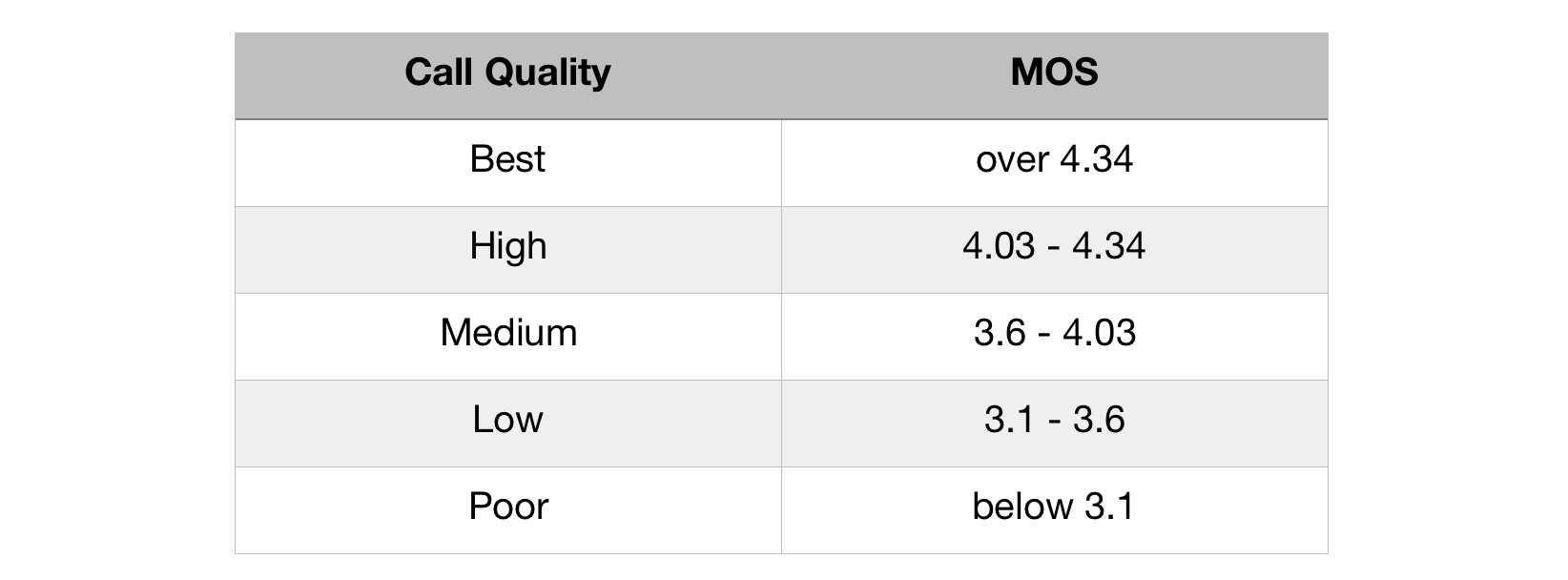
Because most people are not very familiar with the MOS Score and the interpretation of MOS in VoIP Quality, Obkio redesigned the MOS Score graph to create the VoIP Quality graph. Obkio’s MOS VoIP Quality graph categorizes, for every minute, the MOS Call Quality as
- Best
- High
- Medium
- Low
- or Poor
The exact MOS Voice Quality Score is always available in the graph tooltip.
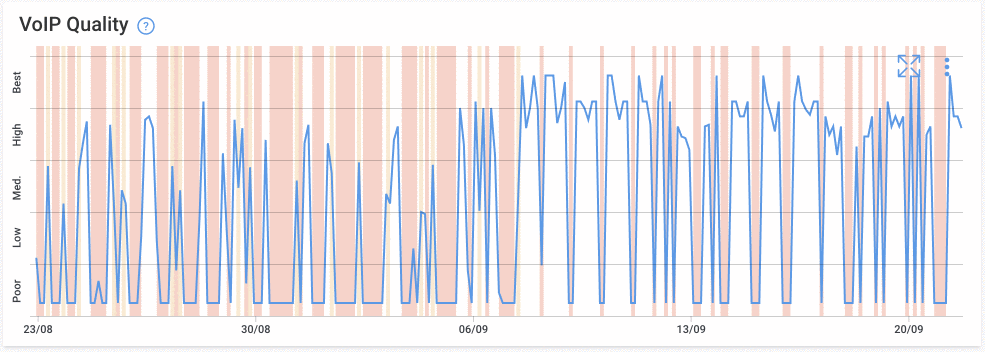

This feature is a great measure of the Quality of Experience (QoE) for users using VoIP applications over their network and helps IT Pros evaluate the impact of Network Performance on VoIP Applications.
A VoIP monitoring tool is a vital component in ensuring accurate and continuous VoIP Quality measurement. That's where Obkio Network Performance Monitoring software comes in.
Obkio offers a comprehensive suite of network monitoring and troubleshooting tools, including its own VoIP Monitoring feature. With Obkio's VoIP Monitoring tool, businesses can easily measure and monitor VoIP quality metrics in real-time, gain valuable insights into their VoIP performance, and quickly troubleshoot and resolve issues.
Network performance plays a crucial role in determining VoIP quality. During a VoIP call, voice data is transmitted over the internet, and any problems with the network can lead to delays, packet loss, and other issues that can impact the call quality. That's why it's essential to monitor both network and VoIP quality together.
With Obkio's VoIP Monitor, you can measure VoIP quality using the MOS score and proactively identify and troubleshoot VoIP issues before they even affect your users. Obkio's user-friendly interface and real-time monitoring make it easy to keep your VoIP system running smoothly and ensure the best possible call quality.

For continuous VoIP monitoring in all your network locations, for all your core VoIP apps, you need to deploy Network Monitoring Agents which continuously measure network performance in key network locations like offices, data centers and clouds.
The Agents exchange synthetic traffic with each other to measure core network metrics that are essential to VoIP monitoring, like MOS score, VoIP Quality, packet loss, jitter, and more.
To collect the data you need to translate, you’ll need:
- Local Agents: Installed in the targeted office location experiencing VoIP Quality issues. There are several Agent types available (all with the same features), and they can be installed on MacOS, Windows, Linux and more.
- Public Monitoring Agent: These are deployed over the Internet and managed by Obkio. They compare network and VoIP performance up to the Internet and can be used to monitor VoIP Quality for apps like Microsoft Teams and Zoom. They can also help identify if the network and VoIP issue are global or specific to a destination.
As we explained earlier, a tool like Obkio will automatically measure your VoIP Quality for you! Once your Monitoring Agents are deployed, they will start exchanging synthetic traffic to measure VoIP Quality.
Obkio’s MOS VoIP Quality graph categorizes, for every minute, the MOS Call Quality as
- Best
- High
- Medium
- Low
- or Poor
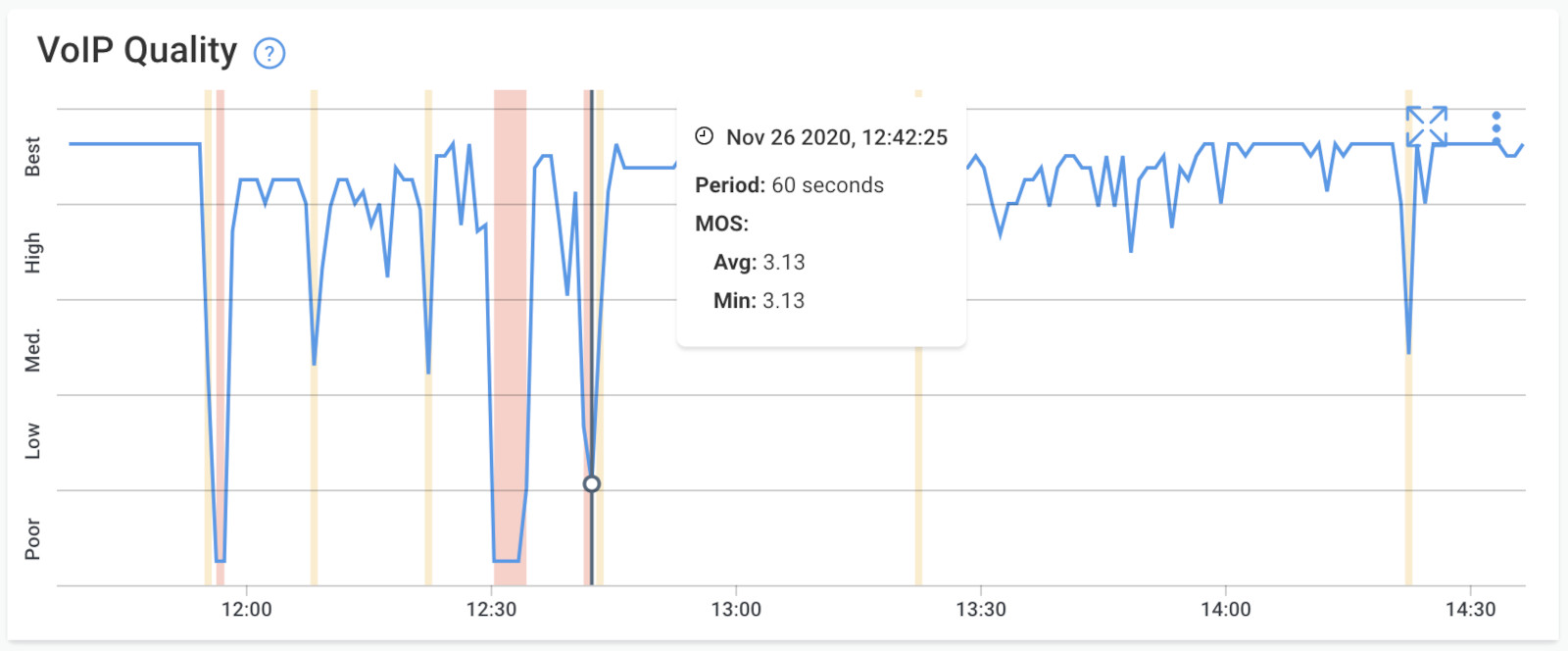
In general, a MOS score of 4 or above is considered to be high-quality audio and indicative of a good VoIP experience. This means that users perceive the audio quality to be similar to that of a traditional phone call.
On the other hand, a MOS score of less than 3 is considered to be low-quality audio and indicative of a poor VoIP experience. This means that the audio quality is distorted, choppy, or robotic-sounding, making it difficult for users to understand the conversation.
Overall, aiming for a high MOS rate is important for delivering a good VoIP experience and ensuring that users are satisfied with the audio quality of their calls.
Once you’ve deployed Obkio Monitoring Agents in your key network locations, they will start measuring other key network metrics that are essential to your network and VoIP performance.
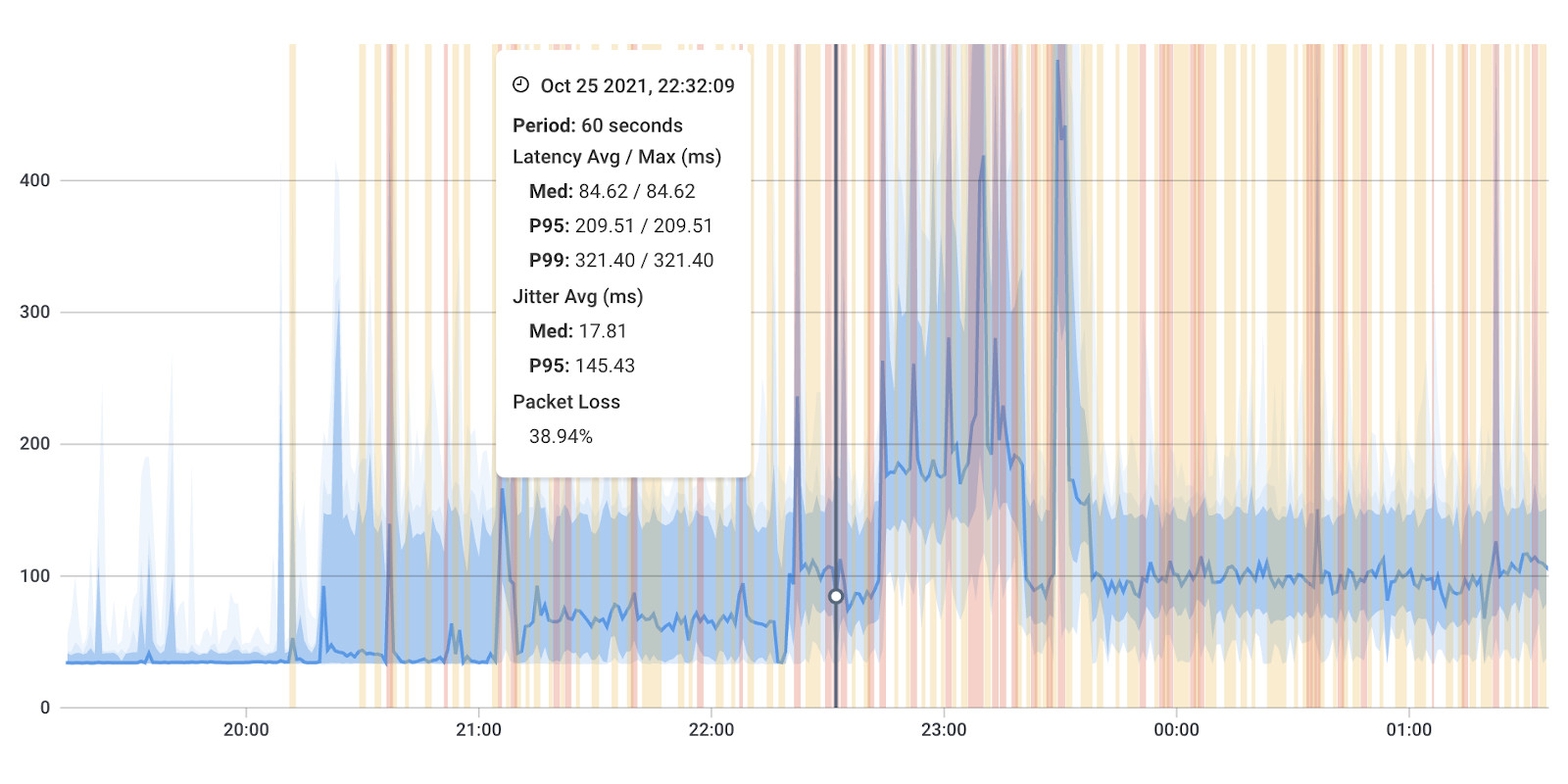
Businesses can track key performance metrics like latency, jitter, packet loss, and more to proactively detect and resolve issues that can cause poor call quality. By monitoring these metrics, businesses can ensure that their VoIP systems are operating at peak performance and delivering the best possible experience to their users.
Let’s get into what metrics you should measure for VoIP!
VoIP monitoring isn't just about keeping your calls crystal clear - it's also about measuring and monitoring key metrics that can affect the quality of your calls. From latency to packet loss, there are several metrics that need to be tracked to ensure a great user experience. So, grab your coffee and let's dive into the metrics you need to know to monitor VoIP quality like a pro!
Latency is a critical metric to monitor for VoIP because it measures the time it takes for a voice packet to travel from one endpoint to another. High latency can result in delays, which can make conversations feel unnatural and frustrating. For example, when there's a delay between when you speak and when the other person hears you, it can create awkward pauses and interruptions.
To measure latency for VoIP monitoring, you'll need to track the time it takes for packets to travel between endpoints. This can be done using a variety of tools, including network performance monitoring software like Obkio. By monitoring latency in real-time, businesses can identify latency spikes and take action to address them before they negatively impact the user experience.
Jitter is another important metric to measure for VoIP because it measures the variation in delay between the arrival of voice packets at the receiving endpoint. VoIP Jitter especially can result in choppy audio, which can make it difficult to understand the person on the other end of the call. When there's high jitter, voice packets may arrive out of order, causing the audio to sound distorted.
To measure jitter for VoIP monitoring, you'll need to track the variation in delay between voice packets as they arrive at the receiving endpoint. Jitter can be measured using specialized network monitoring tools that capture and analyze VoIP traffic. These tools can identify patterns of variation in packet delay and alert administrators when jitter levels exceed acceptable thresholds.
In addition, monitoring jitter can also help businesses identify other network performance issues that may be impacting VoIP quality, such as network congestion or QoS (Quality of Service) settings. By monitoring jitter along with other key metrics, businesses can take proactive steps to ensure they're providing the best possible VoIP experience for their users.
Learn how to measure network jitter using Obkio’s Network Monitoring software to identify network problems & collect data to troubleshoot.
Learn more

Packet loss is a critical metric to measure for VoIP because it directly affects the quality of the audio. When packets are lost, there are gaps in the audio, which can make it difficult to understand the person on the other end of the call. In severe cases, the call can even be dropped entirely.
To measure packet loss for VoIP monitoring, you'll need to track the percentage of voice packets that are lost during transmission. This can be done using specialized network monitoring tools that capture and analyze VoIP traffic. These tools can identify patterns of lost packets and alert administrators when packet loss rates exceed acceptable thresholds.
In addition, monitoring packet loss can also help businesses identify other network performance issues that may be impacting VoIP quality, such as network congestion or problems with the network hardware. By monitoring packet loss along with other key metrics, businesses can take proactive steps to ensure they're providing the best possible VoIP experience for their users.
We already covered MOS score earlier in the article, so here’s just a little recap. MOS, or Mean Opinion Score, is a widely used metric for assessing the quality of voice communications, including VoIP. MOS score is measured on a scale of 1 to 5, with 5 being the best possible score. It's based on subjective feedback from human listeners who rate the quality of a voice transmission on factors like clarity, echo, and distortion.
To measure MOS score for VoIP monitoring, specialized network monitoring tools can capture and analyze VoIP traffic, then use algorithms to calculate an estimated MOS score based on the quality of the audio stream. MOS score can be influenced by many factors, including network performance, codec selection, and jitter. Therefore, monitoring MOS score can help businesses identify and troubleshoot issues that are affecting VoIP quality.
One of the benefits of using MOS score for VoIP monitoring is that it provides a more accurate representation of the user's actual experience compared to other metrics like latency, jitter, and packet loss. This is because MOS score is based on subjective feedback from human listeners, which takes into account factors that can't be accurately measured using automated tools.
VoIP Quality is a term that encompasses many different factors that contribute to the overall quality of a VoIP call. These factors include metrics like latency, jitter, packet loss, and MOS score, which we discussed in the previous questions.
To measure VoIP Quality for VoIP Monitoring, specialized network monitoring tools can capture and analyze VoIP traffic to measure the key metrics that impact call quality. These metrics can be monitored in real-time, and businesses can set thresholds for acceptable values for each metric. If a threshold is exceeded, the monitoring tool can send an alert to the IT team, so they can investigate and resolve the issue before it impacts users.
Measuring VoIP Quality is essential because it ensures that businesses can provide the best possible VoIP experience for their users. Poor VoIP Quality can lead to dropped calls, delayed conversations, and overall frustration for users. By monitoring VoIP Quality in real-time, businesses can identify and resolve issues before they impact users.
One important thing to note is that VoIP Quality can vary depending on the location and network of the user. Therefore, it's essential to monitor VoIP Quality from multiple locations to ensure a comprehensive understanding of call quality.
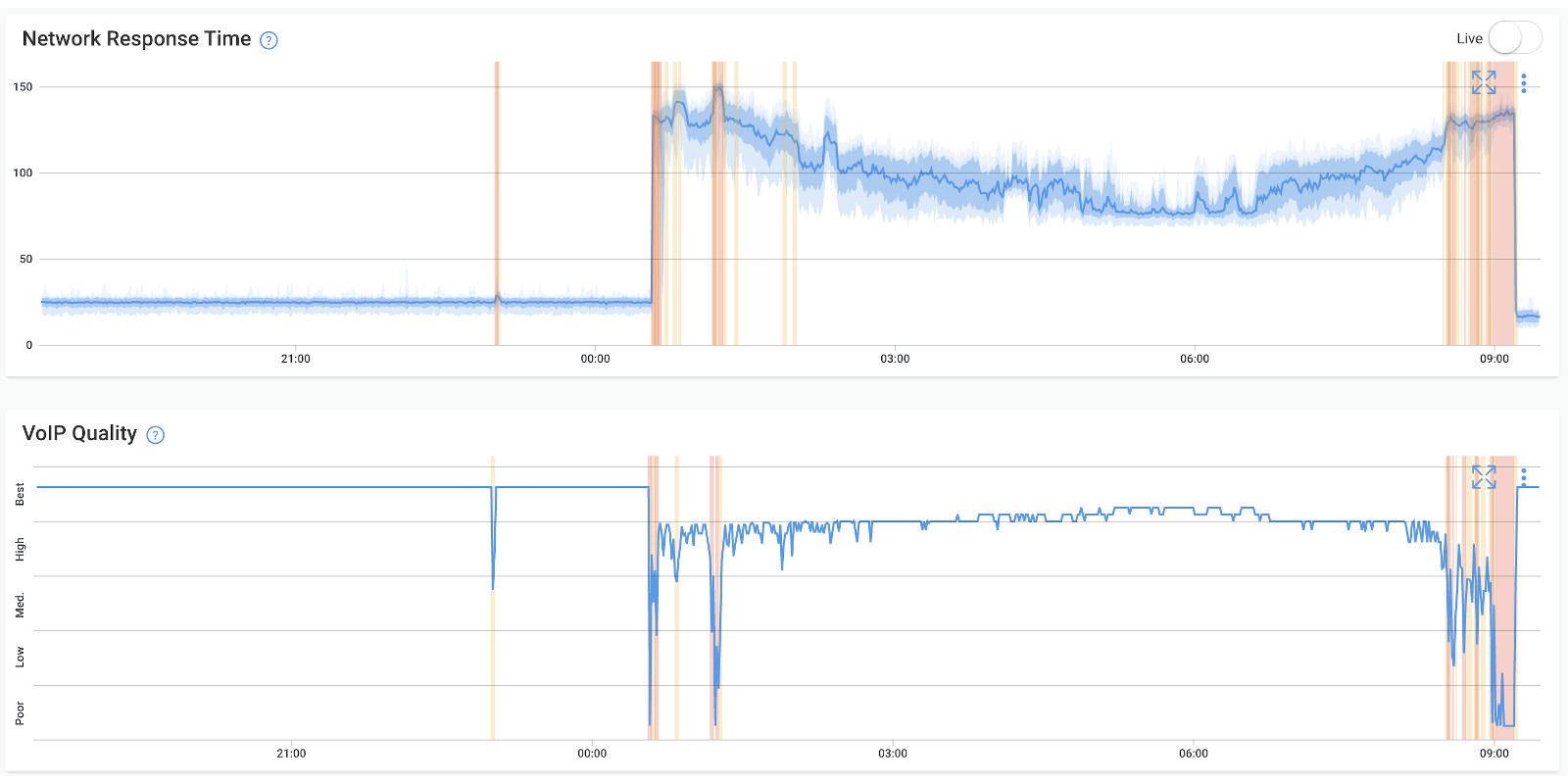

R-factor is another metric commonly used in VoIP monitoring to assess call quality. It stands for "Rating Factor" and is a numerical score ranging from 0 to 100. Higher R-factor values indicate better call quality, while lower values indicate poorer quality.
R-factor takes into account several factors, including delay, packet loss, and jitter, to provide an overall rating of the call quality. It provides a comprehensive assessment of the end-to-end voice quality experienced by users.
To measure R-factor for VoIP monitoring, specialized network monitoring tools can analyze the network conditions and characteristics of the VoIP call. These tools consider factors such as round-trip delay, packet loss rate, and network jitter to calculate the R-factor score.
Measuring R-factor helps businesses in understanding the quality of their VoIP calls from a technical perspective. It provides a quantitative measure that can be used to compare call quality across different calls, endpoints, or networks.
By monitoring R-factor values, businesses can identify trends and patterns related to call quality. They can proactively address issues that lead to lower R-factor scores, such as network congestion, equipment problems, or insufficient bandwidth.
Quality of Service (QoS) is a crucial aspect of VoIP monitoring that focuses on measuring and maintaining the performance and reliability of a network to ensure optimal VoIP call quality. QoS aims to prioritize VoIP traffic and allocate the necessary network resources to prevent issues such as latency, jitter, and packet loss.
Measuring QoS for VoIP monitoring involves assessing various factors that impact call quality. Here are some key aspects:
- Bandwidth allocation: QoS ensures that sufficient bandwidth is allocated to VoIP traffic to prevent congestion and guarantee smooth transmission of voice packets. Monitoring the bandwidth utilization and prioritizing VoIP traffic over other data traffic can help maintain consistent call quality.
- Traffic prioritization: QoS involves assigning priorities to different types of network traffic. VoIP packets should be given a higher priority than other types of data to minimize latency and ensure timely delivery of voice packets. Monitoring the prioritization of VoIP traffic and adjusting QoS settings as needed can enhance call quality.
- Packet loss prevention: QoS mechanisms can help reduce packet loss by employing techniques such as packet buffering, error correction, and congestion avoidance. Monitoring packet loss rates and analyzing network conditions can help identify areas where packet loss is occurring and take corrective actions.
- Latency and jitter control: QoS mechanisms can mitigate latency and jitter issues by implementing features like traffic shaping, queuing algorithms, and buffer management. Monitoring latency and jitter levels in real-time can help identify potential bottlenecks and implement appropriate QoS measures to maintain optimal call quality.
By measuring and monitoring QoS for VoIP, businesses can proactively manage their network infrastructure, prioritize VoIP traffic, and ensure a consistent and reliable voice communication experience for their users.
Optimize VoIP performance with QoS implementation. Explore best practices for QoS for VoIP, overcome challenges, and elevate clarity with Obkio's NPM tool.
Learn more

Quality of Experience (QoE) is a critical aspect of VoIP monitoring that focuses on assessing the end-user’s subjective perception of the overall quality of a VoIP call. QoE takes into account factors such as audio clarity, echo, background noise, and overall user satisfaction.
Measuring QoE for VoIP monitoring involves capturing and analyzing user feedback and subjective assessments to gain insights into the user's perception of call quality. Here are some key aspects to consider:
- User surveys and feedback: Conducting user surveys and collecting feedback from VoIP call participants can provide valuable insights into their subjective experience. Questions related to call clarity, audio quality, echo, and overall satisfaction can help gauge the QoE.
- MOS score: Mean Opinion Score (MOS) is a widely used metric to assess perceived voice quality. MOS is typically obtained through subjective assessments where listeners rate the call quality on a scale from 1 to 5. Monitoring MOS scores across VoIP calls can provide a quantitative measure of QoE.
- Call statistics and metrics: Monitoring various call statistics and metrics, such as latency, jitter, packet loss, and call setup time, can indirectly contribute to assessing QoE. By analyzing these metrics, administrators can identify potential issues that may impact the user's experience.
- Real-time monitoring: Real-time monitoring of key parameters during a VoIP call, such as network performance, call quality, and audio characteristics, can provide immediate insights into the user's experience. Monitoring tools can capture and analyze these real-time metrics to identify potential issues affecting QoE.
By measuring QoE for VoIP monitoring, businesses can gain a deeper understanding of how users perceive the quality of their VoIP calls. This information can help in making informed decisions regarding network optimizations, codec selection, QoS configurations, and overall infrastructure improvements to enhance the overall user experience.
Now we’re going to explore the myriad applications where VoIP monitoring shines, making communication magic happen. So, hold onto your headsets and prepare to be amazed by the wonders of VoIP monitoring in action!
VoIP monitoring is beneficial for a wide range of applications, ensuring optimal call quality and performance. Here are some key applications where VoIP monitoring proves invaluable:
- Business Communication: VoIP monitoring helps businesses maintain high-quality voice communication, ensuring seamless collaboration, customer interactions, and internal communication. It ensures that important calls are crisp and clear, without disruptions or degradation.
- Contact Centers: Contact centers heavily rely on VoIP for their customer interactions. Monitoring VoIP quality in contact centers is crucial to ensure excellent customer experiences, minimize call drops, address latency issues, and maintain superior call quality for effective customer support.
- Remote Workforce: With the rise of remote work, VoIP has become a lifeline for remote teams. VoIP monitoring ensures that remote employees can communicate effortlessly and reliably, irrespective of their location. It helps diagnose and troubleshoot any issues that may arise due to varying network conditions.
- Unified Communications (UC): VoIP is often a key component of UC systems that integrate various communication channels like voice, video, messaging, and conferencing. Monitoring VoIP quality within a UC environment ensures smooth and uninterrupted communication across all channels.
- Service Providers: VoIP monitoring is critical for service providers offering voice services. It allows them to assess call quality, identify potential issues, and maintain service level agreements (SLAs) with their customers. Monitoring helps service providers proactively address network-related problems and deliver superior voice service.
- Network Optimization: VoIP monitoring plays a vital role in optimizing network infrastructure to support VoIP traffic. By monitoring network performance metrics, identifying bottlenecks, and analyzing call quality data, organizations can optimize network configurations, adjust QoS settings, and ensure a network environment conducive to VoIP.
- Troubleshooting and Maintenance: VoIP monitoring assists in troubleshooting and maintenance activities by providing real-time data on call quality, network performance, and related metrics. It helps IT teams quickly pinpoint and resolve issues, reducing downtime and minimizing the impact on communication services.
By leveraging VoIP monitoring across these applications, organizations can enhance their communication capabilities, deliver exceptional user experiences, and ensure that their voice communication remains reliable, efficient, and of the highest quality.
Learn to monitor Zoom network performance to find Zoom jitter, Zoom packet loss & “Your Internet Connection is Unstable” Zoom performance issues on calls.
Learn more

As we embark on our quest to unravel the secrets of VoIP monitoring, it's essential to equip ourselves with the knowledge of the varied tools at our disposal. Prepare to dive into a magical world of comprehensive insights, where we'll uncover the enchanted arsenal of VoIP monitoring tools.
VoIP monitoring requires specialized software tools that can capture and analyze the performance of the VoIP system. Here are the types of software that can be used for VoIP monitoring:
- Network Performance Monitoring (NPM) Software: NPM software provides real-time monitoring of network performance, including network latency, jitter, and packet loss. Network Performance Monitoring tools can be used to monitor VoIP systems and ensure that the network is functioning optimally.
- Application Performance Monitoring (APM) Software: APM software is used to monitor the performance of the VoIP application itself. APM tools can capture and analyze data such as server response time, application response time, and other application-related data to identify and resolve issues with the VoIP application.
- Unified Communications (UC) Monitoring Software: UC monitoring software is designed specifically for monitoring and managing VoIP and other unified communication systems. This software can capture and analyze data from multiple sources, including VoIP systems, to provide a comprehensive view of the overall system performance.
- Call Quality Monitoring (CQM) Software: CQM software is used to monitor the quality of individual VoIP calls. This software captures and analyzes data such as call duration, call quality, and call drop rates to identify and resolve issues with call quality.
- VoIP Protocol Analyzer Software: VoIP protocol analyzer software captures and analyzes the data transmitted over the VoIP protocol, including call signalling, media streams, and other VoIP-related data. This software can help identify issues with the VoIP protocol and ensure that it is functioning efficiently and effectively.
In summary, VoIP monitoring encompasses a range of software options tailored to different aspects of the monitoring process. These include network performance monitoring software, call quality monitoring software, VoIP protocol analyzer software, application performance monitoring software, security information and event management software, and unified communications monitoring software. With this diverse array of tools at their disposal, organizations can select the software that best aligns with their unique monitoring needs and requirements.
With an arsenal of monitoring techniques, we embark on an exciting journey through the labyrinth of VoIP systems, equipped with the power to slay latency beasts, outwit packet loss tricksters, and decode the mysteries of call performance. So, fasten your seatbelts, put on your monitoring capes, and join us on this thrilling adventure as we unveil the captivating techniques that ensure VoIP excellence like never before!
VoIP monitoring employs various techniques to ensure comprehensive monitoring and analysis of VoIP systems. Here are some commonly used techniques for VoIP monitoring:
- Active Monitoring: Active monitoring involves simulating VoIP traffic and generating test calls to measure and assess call quality. This technique helps proactively identify issues by actively monitoring key metrics such as latency, jitter, packet loss, and MOS score. Active monitoring is particularly useful for ongoing performance evaluation and troubleshooting.
- Passive Monitoring: Passive monitoring involves capturing and analyzing network traffic to extract relevant VoIP-related data. It monitors live VoIP sessions and records packets without actively generating test calls. Passive monitoring provides insights into real-world VoIP performance, allowing for in-depth analysis of call quality metrics, network behaviour, and protocol-level details.
- Call Detail Record (CDR) Analysis: VoIP systems generate call detail records, which contain information about each call, including call duration, parties involved, call quality metrics, and more. Analyzing CDRs provides valuable insights into call patterns, call quality statistics, and helps identify specific call-related issues.
- Protocol Analysis: VoIP monitoring tools can analyze VoIP protocols, such as SIP (Session Initiation Protocol), RTP (Real-time Transport Protocol), and others. By examining protocol-level details, including signalling messages, media streams, and codec usage, protocol analysis helps diagnose issues related to call setup, media negotiation, and codec performance.
- Quality of Service (QoS) Monitoring: QoS monitoring focuses on tracking and analyzing network performance metrics to ensure adequate bandwidth, prioritize VoIP traffic, and maintain optimal call quality. It involves monitoring key QoS parameters, such as network latency, jitter, packet loss, and bandwidth utilization, to identify potential bottlenecks and ensure a suitable network environment for VoIP traffic.
- End-to-End Testing: End-to-end testing involves conducting comprehensive tests that mimic real-world VoIP scenarios. This technique assesses call quality and network performance across the entire VoIP infrastructure, including network segments, devices, and endpoints. End-to-end testing helps identify bottlenecks, misconfigurations, and other issues that may affect call quality throughout the system.
By employing these techniques, businesses can gain deep insights into their VoIP systems, detect performance issues, troubleshoot problems, and optimize call quality, ensuring a seamless and superior communication experience.
Navigating the world of VoIP monitoring can sometimes feel like exploring a maze of network complexities, with intermittent challenges popping up like mischievous creatures along the way. But fear not, brave VoIP adventurer! We're here to equip you with the tools to overcome these obstacles and ensure crystal-clear communication.
From battling network congestion to taming intermittent network gremlins, let's dive into the realm of VoIP monitoring challenges and discover how to conquer them with a dash of technical prowess and a sprinkle of humour.
- Network Complexity: Modern networks often have diverse architectures, involving multiple locations, different network technologies, and various devices. This complexity can make it challenging to monitor VoIP effectively. To address this challenge, consider using network monitoring tools that offer comprehensive visibility across the entire network infrastructure. These tools should support multiple network protocols and provide centralized monitoring and management capabilities.
- Intermittent Network Problems: VoIP monitoring can be challenging when network issues occur sporadically or intermittently. Intermittent network problems may be transient in nature and difficult to capture during regular monitoring intervals. The intermittent nature of these issues can make it challenging to diagnose and troubleshoot the root cause. To address this challenge, consider implementing continuous or real-time monitoring solutions that can capture and analyze network performance metrics at frequent intervals. These tools can help capture intermittent issues more effectively and provide detailed data for analysis during periods of network instability.
- Network Congestion: Network congestion can significantly impact VoIP call quality by causing delays, packet loss, and jitter. To address this challenge, implement Quality of Service (QoS) mechanisms that prioritize VoIP traffic over other data types. Additionally, monitoring network traffic patterns and bandwidth utilization can help identify congestion points and take appropriate measures to alleviate the issue.
- Variable Network Conditions: VoIP calls can traverse different networks with varying conditions, such as public internet connections or private networks. Monitoring VoIP quality across these different environments can be a challenge. To address this, consider deploying monitoring agents or probes in multiple locations to capture VoIP metrics from different network segments. This provides a broader perspective and helps identify issues specific to certain locations or networks.
- Codec Variations: VoIP systems can employ different audio codecs to compress and transmit voice data. Each codec may have its own impact on call quality. Monitoring and managing these codec variations can be challenging. Ensure that your monitoring tools support the specific codecs used in your VoIP system and can accurately assess call quality regardless of the codec in use.
- End-to-End Visibility: VoIP calls involve multiple components, including endpoints, PBX systems, routers, gateways, and more. Ensuring end-to-end visibility across all these components can be complex. Implement monitoring solutions that provide visibility into each component and their interactions. This allows for comprehensive troubleshooting and identification of performance bottlenecks or issues affecting call quality.
- Scalability: As the number of VoIP users or call volumes increases, monitoring systems must be able to handle the scalability requirements. Ensure that your monitoring solution can scale effectively to accommodate growing VoIP traffic and provide accurate and timely metrics for all calls.
By addressing these challenges, businesses can effectively monitor VoIP performance, proactively identify issues impacting call quality, and take appropriate measures to ensure a reliable and high-quality VoIP experience for users.


Gather 'round as we embark on a quest to unravel the mysteries of VoIP monitoring! At the heart of this adventure lies a noble goal: to identify and tame the mischievous VoIP issues that can disrupt our communication realms. With our trusty VoIP monitoring tools in hand, we'll venture into the realm of call quality, armed with the power to spot latency dragons, slay packet loss goblins, and conquer jittery beasts.
VoIP monitoring can help uncover various performance issues that may arise in a VoIP system. Here are some common VoIP performance issues that can be identified using VoIP monitoring:
- Network Latency: VoIP calls can be affected by excessive network latency, resulting in noticeable delays or lag in the conversation. VoIP monitoring can measure latency and identify instances where it exceeds acceptable thresholds, helping pinpoint network segments or devices causing the latency.
- Jitter: Jitter refers to variations in packet delay, causing irregularities in the arrival of voice packets at the destination. High jitter can lead to choppy or distorted audio during VoIP calls. VoIP monitoring tools can measure jitter and identify network components or congestion points contributing to its occurrence.
- Packet Loss: Packet loss occurs when voice packets are not successfully delivered to their destination. This can result in gaps or dropouts in the audio during a VoIP call. VoIP monitoring can detect packet loss and help determine the network segments or devices responsible for the loss, allowing for prompt troubleshooting and resolution.
- Network Congestion: Congested network links or devices can negatively impact VoIP call quality by introducing increased latency, jitter, and packet loss. VoIP monitoring can detect congestion by monitoring network utilization and provide insights into the specific areas experiencing congestion, allowing for proactive network optimization.
- Codec Issues: Different voice codecs are used to compress and decompress voice data during VoIP calls. Incompatibilities, misconfigurations, or performance issues with codecs can degrade call quality. VoIP monitoring tools can assess the codec usage and identify any problems associated with specific codecs, helping troubleshoot codec-related issues.
- Quality of Service (QoS) Misconfigurations: QoS settings are crucial for prioritizing VoIP traffic over other types of network traffic. Misconfigurations or inadequate QoS policies can result in suboptimal call quality. VoIP monitoring can evaluate QoS policies and identify any misconfigurations or inconsistencies that may impact call quality.
- Call Drops and Disconnects: VoIP monitoring can detect instances of call drops or unexpected call disconnections, providing visibility into the frequency and potential causes of such issues. This information helps identify network components, call routing problems, or network instabilities that may be responsible for call disruptions.
By leveraging VoIP monitoring, businesses can proactively identify and address these performance issues, ensuring high-quality and reliable VoIP communications for their users.
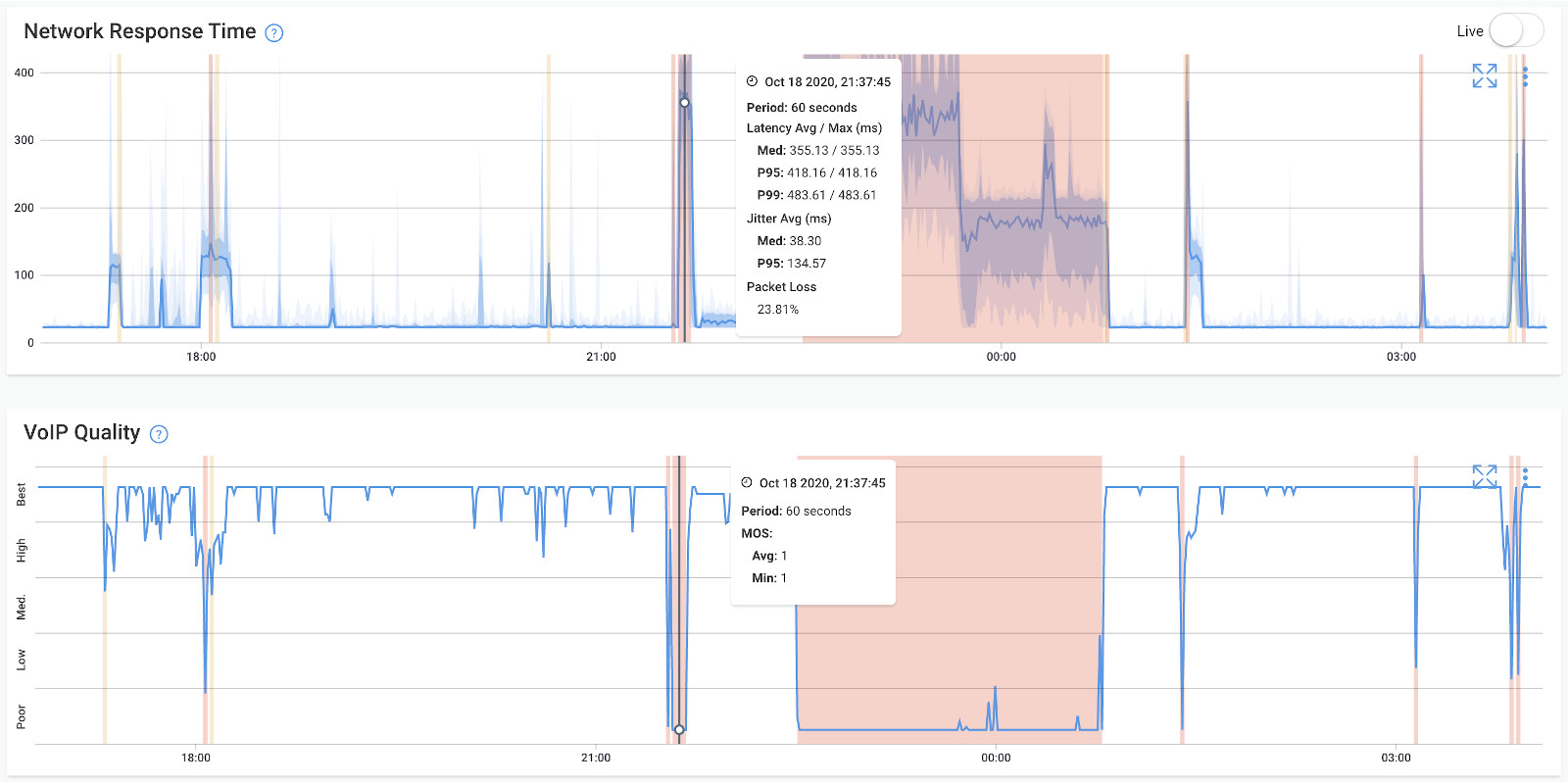
Imagine you're on a VoIP call with a customer, discussing an important project, when suddenly your voice sounds like a robot on roller skates, with echoes that make you feel like you're talking to yourself from the future. What's going on? It's the mischievous culprit known as 'jitter'!
In the world of Voice over Internet Protocol (VoIP), jitter is the party crasher that messes with your voice packets' perfect timing. Let's dive into this wild, wobbly world of jitter and see how to keep your VoIP calls smooth and distortion-free.
Jitter in VoIP refers to the variation in the delay of packet arrival when transmitting voice data over a network. VoIP technology relies on breaking audio data into small packets and sending them over the internet or a network. Ideally, these packets should arrive at their destination at a consistent rate and with a consistent delay. However, network congestion, routing issues, and other factors can lead to variations in the arrival time of these packets, resulting in jitter.
Jitter can negatively impact the quality of a VoIP call in several ways:
- Audio Distortion: Variations in packet arrival times can lead to audio distortion, including choppy or garbled speech, making it difficult for users to understand each other.
- Echo: Jitter can also contribute to echo in a VoIP call, where users hear their own voice with a delay, which can be distracting and disruptive.
- Latency: High jitter can increase overall call latency, causing delays in conversations, which can be especially problematic for real-time communication.
To mitigate jitter in VoIP calls, various techniques are used, including:
- Buffering: VoIP devices can use jitter buffers to temporarily store incoming packets and then play them out at a more regular interval. This can help smooth out variations in packet arrival times.
- Quality of Service (QoS): Network administrators can implement QoS policies to prioritize VoIP traffic over other types of data, ensuring that voice packets receive preferential treatment and minimizing jitter.
- Traffic Prioritization: Prioritizing VoIP traffic on routers and switches can also help reduce jitter by giving voice packets priority in network queues.
- Network Monitoring: Real-time monitoring of network conditions can help identify and address issues that contribute to jitter, such as network congestion or high packet loss.
- Packet Loss Concealment: VoIP systems may employ packet loss concealment techniques to mask the effects of lost or out-of-order packets, improving the perceived audio quality during calls.
Overall, managing jitter is essential for maintaining high-quality VoIP communication and ensuring a smooth and clear voice conversation over the internet or a network.
Learn what network jitter is, how it affects VoIP & video calls, and proven methods to measure and reduce jitter in your network
Learn more

So jitter in VoIP makes you sound like robot, now latency VoIP is a whole other demon!
Image you're on a call and suddenly there's a pause long enough to make you wonder if they've time-traveled to the future. Nope, it's just the mischievous 'latency' playing tricks on your VoIP call! Latency is the time-traveler of the digital world, adding a delay to your voice as it zooms through the Internet.
Latency in VoIP refers to the delay or lag in the transmission of voice data over a network. It is the time it takes for an audio signal to travel from the sender to the receiver in a VoIP call. Latency is typically measured in milliseconds (ms) and can have a significant impact on the quality of a VoIP call.
There are three main types of latency in VoIP:
- Transmission Latency: This is the delay caused by encoding and compressing the audio signal, transmitting it over the network, and then decoding and decompressing it at the receiver's end. While modern VoIP systems aim to minimize this type of latency, it still exists to some extent.
- Propagation Latency: This is the time it takes for the data packets to physically travel across the network infrastructure, including routers, switches, and cables. Propagation latency is influenced by the physical distance between the sender and receiver and the speed at which data travels through the network.
- Processing Latency: This refers to the time it takes for the VoIP devices (phones, computers, or servers) to process the audio data and convert it into digital packets. Processing latency can vary depending on the performance of the devices and the efficiency of the VoIP software or hardware.
Latency can have several effects on a VoIP call:
- Delay in Conversations: High latency can result in noticeable delays in conversations. This delay can be frustrating for users because it interrupts the natural flow of communication.
- Echo: Latency can contribute to echo in a VoIP call, where users hear their own voice with a delay, making it challenging to have a smooth conversation.
- Reduced Call Quality: Excessive latency can lead to call quality issues, such as choppy audio or dropped words, which can negatively impact the overall user experience.
To ensure a good VoIP experience, it's important to keep latency as low as possible. Minimizing latency is essential for maintaining clear and real-time communication in VoIP calls. Here's how!
Certainly! Expanding on how to keep latency low to ensure a good VoIP experience:
1. High-Quality Network Connections:
- High-Speed Internet: A fast and reliable internet connection with sufficient bandwidth is crucial for minimizing latency in VoIP calls. Consider upgrading your internet plan if you frequently experience latency issues.
- Wired Connection: Using an Ethernet cable instead of a Wi-Fi connection can reduce latency, as wired connections are generally more stable and have lower latency than wireless connections.
2. Quality of Service (QoS) Policies:
- Traffic Prioritization: Implementing QoS policies on your network can help prioritize VoIP traffic over other types of data. By giving VoIP packets higher priority, you can ensure that they are transmitted with minimal delay, even during network congestion.
3. Efficient VoIP Hardware and Software:
- VoIP Phones and Headsets: Invest in high-quality VoIP phones or headsets that are designed for clear audio and have built-in echo cancellation and noise reduction features. These devices can help reduce latency-related issues.
- VoIP Service Providers: Choose a reputable VoIP service provider that offers low-latency solutions. Some providers have data centers strategically located to minimize the distance data must travel, reducing latency.
- Codec Selection: Opt for efficient audio codecs that provide good voice quality while minimizing the amount of data sent over the network. Some codecs are better suited for low-latency applications.
- VoIP Software Updates: Keep your VoIP software and firmware up to date. Software updates often include improvements that can reduce latency and enhance call quality.
4. Network Monitoring and Troubleshooting:
- Regularly monitor your network for latency issues using network diagnostic tools. Identify and address any network bottlenecks, excessive packet loss, or other issues that may contribute to latency.
- Conduct periodic network assessments to ensure that your network infrastructure can handle the demands of VoIP traffic.
5. Redundancy and Failover:
- Implement network redundancy and network failover solutions to minimize downtime in case of network outages. Redundancy can help maintain low latency/good latency and prevent call interruptions.
By taking these steps to minimize latency, you can significantly improve the quality of your VoIP calls, ensuring that they remain clear, real-time, and free from frustrating delays or disruptions. A low-latency VoIP setup is essential for effective communication in both professional and personal contexts.
We asked a supercomputer “What is latency”, its impact on network performance, and strategies for minimizing it and created this comprehensive guide.
Learn more

Prepare to be amazed as we dive into the vibrant world of VoIP monitoring and unlock the secrets to enhancing call quality. With our trusty monitoring tools by our side, we embark on an exhilarating quest to optimize VoIP quality like never before. Together, we'll conquer latency monsters, outsmart jittery jesters, and banish packet loss villains from our communication realm. So, tighten your seatbelts, unleash your troubleshooting prowess, and join us on this whimsical journey as we harness the power of VoIP monitoring to achieve unparalleled call quality perfection!
VoIP monitoring provides a wealth of insights and data that can be leveraged to optimize VoIP quality. Here are some ways in which VoIP monitoring can help optimize VoIP quality:
- Performance Baselines: VoIP monitoring establishes performance baselines by continuously monitoring key metrics such as latency, jitter, packet loss, and MOS score. These baselines serve as reference points for optimal performance. By comparing real-time data to these baselines, you can quickly identify deviations and take proactive measures to rectify issues before they impact call quality.
- Real-Time Monitoring: VoIP monitoring tools offer real-time visibility into network and call performance. By monitoring key metrics, you can detect any sudden spikes in latency, jitter, or packet loss that may affect VoIP quality. Real-time monitoring enables prompt identification and troubleshooting of issues, minimizing their impact on call quality.
- Proactive Issue Detection: VoIP monitoring tools can proactively detect and alert you to potential issues before they impact call quality. By setting up customized alerts and thresholds, you can receive notifications when certain metrics exceed predefined limits. This allows you to address issues promptly, preventing them from degrading VoIP quality.
- Network Optimization: VoIP monitoring helps identify network bottlenecks and congestion points that can degrade call quality. By analyzing network traffic patterns, you can optimize network configurations, adjust Quality of Service (QoS) settings, or implement traffic prioritization techniques to ensure a smooth flow of VoIP packets and minimize potential disruptions.
- Troubleshooting and Root Cause Analysis: VoIP monitoring provides detailed data and historical logs that facilitate troubleshooting and root cause analysis. When call quality issues arise, you can delve into the monitoring data to identify the specific network segments, devices, or configurations contributing to the problem. This enables targeted troubleshooting and resolution, leading to optimized VoIP quality.
- Capacity Planning: VoIP monitoring helps with capacity planning by monitoring network utilization and call traffic patterns. By understanding call volume trends and network capacity thresholds, you can allocate resources appropriately and ensure that your infrastructure can handle the expected call loads, avoiding congestion and maintaining optimal call quality.
By utilizing VoIP monitoring to its full potential, businesses can optimize VoIP quality, deliver superior call experiences, and ensure seamless communication for their users.

You've made it to the end of this VoIP monitoring extravaganza, armed with knowledge and wisdom aplenty. But before you embark on your own VoIP monitoring adventure, we have one final surprise for you. Presenting the ultimate VoIP monitoring checklist, your trusty companion on the quest for unbeatable call quality! Now that you're equipped with all the insights and techniques, it's time to put your expertise to the test.
- Monitor Network Performance: Track network bandwidth, latency, jitter, and packet loss to identify any network-related issues that may affect VoIP quality.
- Measure Call Quality: Utilize metrics like MOS score, R-factor, and subjective user feedback to assess the quality of individual calls and overall VoIP performance.
- Monitor VoIP Protocols: Analyze VoIP protocols such as SIP and RTP to identify any anomalies or errors that may impact call quality or connectivity.
- Analyze QoS Parameters: Monitor Quality of Service (QoS) parameters like DSCP markings, packet prioritization, and traffic shaping to ensure proper handling of VoIP traffic across the network.
- Track Voice Codec Performance: Keep an eye on the performance of voice codecs being used, ensuring compatibility, efficiency, and optimal utilization of network resources.
- Monitor Endpoint Devices: Monitor the performance of VoIP endpoints, including IP phones, softphones, and conference devices, to identify any device-specific issues affecting call quality.
- Analyze Call Metrics: Track call setup time, call duration, call failure rates, and other call-related metrics to gain insights into call performance and detect patterns or trends.
- Proactive Issue Detection: Set up real-time network monitoring alerts and notifications to proactively identify and address any VoIP performance issues before they escalate and impact user experience.
- Historical Analysis: Maintain historical data and trends of VoIP performance metrics for analysis, capacity planning, and identifying long-term patterns or recurring issues.
- Integrated Reporting: Generate comprehensive reports and visualizations to communicate VoIP performance to stakeholders, providing insights for decision-making and demonstrating the value of VoIP monitoring.
Remember, this checklist serves as a guideline to cover essential aspects of VoIP monitoring. Customize it based on your specific requirements, network architecture, and business needs. By following this checklist diligently, you'll be well-equipped to monitor, manage, and optimize your VoIP system for superior call quality and seamless communication experiences.
And there you have it, fellow adventurers of the VoIP realm! We've embarked on an enlightening journey through the world of VoIP monitoring, unravelling its mysteries, and uncovering the secrets to achieving unparalleled call quality. From measuring latency and jitter to combating packet loss and optimizing QoS, we've explored the tools and techniques that empower us to conquer the challenges of VoIP performance.
But our adventure doesn't end here! To truly elevate your VoIP monitoring game and ensure crystal-clear conversations, we have a special companion to guide you on your quest.
Introducing Obkio, the ultimate ally in VoIP monitoring! With its powerful Network Performance Tool, Application Performance Monitoring Tool, and UC Monitoring Tool, Obkio equips you with real-time insights and proactive troubleshooting capabilities. It's your ticket to a world of optimized VoIP quality, where you can identify and tackle issues before they even cast a shadow on your communication kingdom.
The time has come to unleash the full potential of your VoIP system, unlock the secrets of exceptional call quality, and elevate your communication game to new heights. Embrace Obkio and let the magic of VoIP monitoring transform your world of conversations.
Begin your adventure today with Obkio's Free Trial and experience the wonder of crystal-clear, reliable VoIP communications like never before!
- 14-day free trial of all premium features
- Deploy in just 10 minutes
- Monitor performance in all key network locations
- Measure real-time network metrics
- Identify and troubleshoot live network problems

You can rest assured that we're not like those pushy Sellsy people - there's no catch here. We firmly believe in the excellence of our product, but if it's not the right fit for you, we understand and want what's best for you.


























 Obkio Blog
Obkio Blog




